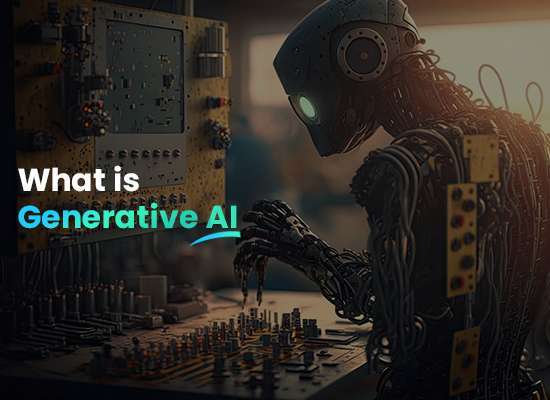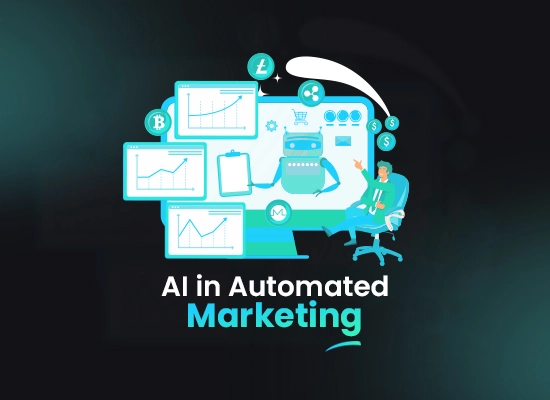
Contents
Generative AI, often referred to as AI integration, encompasses artificial intelligence systems capable of producing text, images, videos, and various content based on provided prompts. The prevalence of AI generators like ChatGPT and DALL-E2 is on the rise worldwide, gaining popularity for their ability to respond to user inputs and generate diverse outputs.
When users submit text prompts to these programs, the generative AI swiftly produces relevant content, be it an outline or a story from ChatGPT or a visually captivating creation such as a Victorian-style painted monkey from DALL-E2. This article delves into the realm of what is generative AI, emphasizing the benefits of generative AI, and explores the expanding landscape of AI integration, shedding light on its uses and functionalities.
The integration of generative AI, also known as “generative artificial intelligence,” revolves around the concept of utilizing various prompts to generate diverse forms of media, encompassing text, photos, movies, sounds, code, and 3D designs. What is generative AI essentially entails the technology’s capability to learn and undergo training by leveraging pre-existing online materials and artifacts. Through continuous exposure to additional data, generative AI evolves and refines its capabilities.
This integration operates in conjunction with AI models and algorithms, which are adeptly trained on extensive, unlabeled datasets requiring substantial processing power and sophisticated mathematical computations. The benefits of generative AI manifest as it learns from these datasets, enabling it to predict outcomes in manners closely resembling actions or creations carried out by humans. The seamless integration of AI further amplifies the advantages of generative AI across various domains.
Generative AI, characterized by its utilization of deep learning—a sophisticated computing technique, revolves around discerning recurring themes and configurations within extensive datasets. Through the AI integration, particularly neural networks, these models emulate the human brain’s absorption and interpretation of information, ultimately learning from it. What is generative AI’s essence lies in its capacity to leverage this acquired knowledge for generating innovative and compelling outcomes.
An exemplification of the capabilities of generative AI integration can be observed when these models are exposed to substantial volumes of fiction writing. Through this process, they adeptly recognize and replicate diverse story elements, encompassing plotlines, character dynamics, thematic elements, and narrative devices. The integration of generative AI, thus, not only highlights its ability to grasp patterns within data but also underscores the manifold benefits of generative AI in yielding fresh, persuasive results across various domains.
The Concept Behind What is Generative AI
Exploring generative AI involves delving into what is generative AI and understanding its evolution from inception to the current era. Generative AI refers to artificial intelligence that utilizes algorithms to generate novel data resembling the provided training data. The inception of generative artificial intelligence dates back to the 1950s when computer scientists began experimenting with algorithms to create innovative datasets, marking the initial stages of generative AI development.
An exemplary model from that time was the Markov Chain, illustrating the application of statistical models for generating new data sequences based on input sequences. Recognizing the historical roots of generative AI is crucial for comprehending the broader landscape of AI integration. The benefits of generative AI extend beyond historical contexts, demonstrating its potential in various domains and highlighting the positive outcomes associated with the integration of generative AI technologies.
In AI integration, the concept of “what is generative AI” has evolved significantly over the years. Back in the 1980s, neural networks emerged as a key algorithmic approach for creating novel data, championed by early proponents like Geoffrey Hinton. Hinton’s “Boltzmann Machines,” with interconnected nodes, became a notable method for generating new data.
Fast forward to 2014, and Ian Goodfellow introduced a groundbreaking technique known as generative adversarial networks (GANs), further shaping the landscape of generative AI. GANs consist of a generator and discriminator working collaboratively to produce data that mirrors the characteristics of the training set.
The benefits of generative AI have been evident, experiencing substantial advancements since its 1950s inception. Recent years have witnessed remarkable progress due to the development of innovative methodologies and algorithms.
Exploring the history of generative AI not only provides insight into its evolution but also enhances our understanding of the challenges and opportunities ahead. This continued exploration is crucial for pushing the boundaries of what is possible with this exciting technology, driving further integration and reaping the numerous benefits of generative AI across diverse applications.
General Processes Involved in Generative AI Integration
The exploration of generative AI revolves around the inquiry of “what is generative AI” and involves the creation of systems capable of producing novel content across various domains like photos, text, and music. The procedures within AI integration for generative AI development can vary, contingent on the particular task and the model employed. Nevertheless, a broad overview of the shared actions and procedures in the development of generative AI underscores the significance of understanding the “benefits of generative AI” in generating diverse forms of data:
1. Define the Task and Objectives:
Articulate precisely what generative AI entails by clearly defining the intended task for the generative model, whether it be image generation, text completion, or style transfer. Emphasize the importance of detailing the objectives and desired outcomes within the AI integration process, highlighting the significance of generating realistic content and attaining a specific level of creativity.
Expound on the numerous benefits of generative AI, showcasing its capacity to revolutionize tasks through advanced capabilities and enhance overall system performance.
2. Data Collection and Preprocessing:
Examine and assemble a premium dataset pertaining to the task at hand, emphasizing the importance of understanding what is generative AI. Take measures to preprocess the acquired data, ensuring its compatibility for training through actions such as resizing images, normalizing text, or addressing missing values.
This meticulous preparation lays the groundwork for effective AI integration, optimizing the potential benefits of generative AI in your project.
3. Choose a Generative Model Architecture:
Articulate precisely what generative AI entails by clearly defining the intended task for the generative model, whether it be image generation, text completion, or style transfer. Emphasize the importance of detailing the objectives and desired outcomes within the AI integration process, highlighting the significance of generating realistic content and attaining a specific level of creativity.
Expound on the numerous benefits of generative AI, showcasing its capacity to revolutionize tasks through advanced capabilities and enhance overall system performance.
Seamless Collaboration | Cost-Efficient Solutions | Faster Time-to-Market

Seamless Collaboration | Cost-Efficient Solutions | Faster Time-to-Market

4. Model Training:
Explore the concept of generative AI by understanding what generative AI is and its significance in AI integration. Begin by splitting the dataset into training, validation, and test sets. Subsequently, embark on training the generative model with the training data, fine-tuning hyperparameters and adjusting the architecture as required. Throughout this process, employ suitable loss functions like mean squared error, cross-entropy, or adversarial loss to guide the training.
Recognize the benefits of generative AI integration, emphasizing its potential in enhancing various applications and systems. The iterative refinement of the generative model showcases the adaptability and effectiveness that generative AI brings to the forefront of AI development.
5. Hyperparameter Tuning:
Explore various hyperparameter configurations to enhance the performance of generative AI models. Fine-tune settings such as learning rates, batch sizes, and other parameters to integrate generative AI seamlessly into your system, unlocking the potential benefits of generative AI.
Tailor these configurations to optimize the overall performance, demonstrating the advantages that result from effective AI integration and the utilization of generative AI technologies.
6. Regularization and Fine-Tuning:
Implementing regularization methods, like dropout, weight decay, or batch normalization, is crucial when delving into AI integration. When fine-tuning the model on the validation set, it is imperative to consider what is generative AI and how it contributes to preventing overfitting.
The benefits of generative AI become apparent as these techniques enhance the model’s ability to generalize effectively to new data, showcasing the significant impact of AI integration on overall model performance.
7. Evaluation Metrics:
Examine the assessment criteria to gauge the effectiveness of generative AI. This entails establishing metrics such as FID (Fréchet Inception Distance) for tasks involving the creation of images or utilizing BLEU scores for the evaluation of text generation.
Understanding what is generative AI and its integration into the evaluation process is crucial for comprehensively appraising the model’s capabilities. Embracing the benefits of generative AI, including enhanced creativity and adaptability, can further enhance the overall evaluation framework, promoting more robust AI integration strategies.
8. Generate and Validate Results:
Explore generative AI, delving into the intricacies of what is generative AI and its transformative capabilities. Engage in the process of AI integration by generating novel samples through a meticulously trained model.
Assess the caliber of the content produced and, based on the validation results, iterate on both the model and the training process. Uncover the manifold benefits of generative AI, recognizing its potential to revolutionize content creation and enhance the overall efficacy of artificial intelligence systems.
9. Deployment and Integration:
Upon achieving contentment with the performance of generative AI, proceed to deploy it within the designated setting. Facilitate seamless AI integration by incorporating the generative model into diverse applications, systems, or workflows according to specific requirements.
Explore the myriad benefits of generative AI in enhancing overall functionality and efficiency throughout the integrated processes. The advantages of employing generative AI extend beyond mere deployment, demonstrating its transformative impact on various aspects of the technological landscape.
10. Continuous Improvement:
Evaluate how generative AI functions by observing its performance in practical situations. Explore the concept of AI integration, specifically regarding what is generative AI. If the model’s performance in real-world scenarios is not optimal, contemplate the benefits of generative AI and assess whether retraining the model with updated data can enhance its adaptability to changes in the underlying distribution.
Emphasize the significance of incorporating generative AI into existing systems for improved outcomes and efficiency.
In the process of exploring generative AI, a pivotal consideration revolves around comprehending ‘what is generative AI’ and integrating it seamlessly into existing AI frameworks. Managing the equilibrium between model complexity, training duration, and computational resources during these stages is imperative. Moreover, it is essential to conscientiously tackle ethical concerns associated with the development of generative AI. Recognizing and optimizing the benefits of generative AI integration is crucial for utilizing its full potential.
Challenges and Limitations That Led to The benefits of Generative AI
While Generative AI offers numerous benefits, industries may face challenges and limitations when not utilizing this technology. Here are some key issues:
1. Inefficient Workflows:
Manual Processes: Without Generative AI, many industries rely on manual processes for tasks like content creation, design, and optimization. This can lead to inefficiencies and slower production cycles.
Human Error: Manual tasks are prone to human errors, which can impact the quality and accuracy of outputs.
2. Limited Creativity and Innovation
Lack of Novelty: Generative AI can generate novel and creative solutions that may not be immediately apparent to humans. Without this technology, industries may struggle to explore new ideas and innovative solutions.
3. Resource Intensiveness
High Resource Costs: Manual tasks can be resource-intensive, requiring significant time and effort. Generative AI can automate and streamline processes, reducing resource costs.
4. Inability to Handle Big Data:
Data Overload: Industries dealing with large datasets may struggle to extract meaningful insights and patterns manually. Generative AI can process vast amounts of data quickly, enabling more effective decision-making.
5. Personalization Challenges:
Generic Solutions: Without Generative AI, industries might struggle to provide personalized products or services, as manually tailoring solutions for individual customers can be time-consuming and impractical.
6. Ineffective Content Generation:
Limited Content Creation: Industries relying solely on human content creators may face challenges in meeting the growing demand for diverse and engaging content. Generative AI can assist in content generation across various media formats.
7. Slow Adaptation to Market Changes:
Lag in Response: Rapid changes in market trends and consumer preferences may catch industries off guard without the ability to quickly adapt. Generative AI can analyze real-time data to identify trends and recommend adaptive strategies.
8. Security Concerns:
Limited Security Measures: Industries may face security challenges without advanced AI systems to detect and respond to cyber threats. Generative AI can enhance cybersecurity by identifying patterns indicative of potential attacks.
9. Biases in Decision-Making:
Human Biases: Manual decision-making processes are susceptible to human biases. Generative AI, if not properly designed and monitored, can inherit or amplify biases present in training data.
10. Training and Implementation Costs:
Initial Investment: Adopting Generative AI requires an initial investment in technology, training, and infrastructure. Some industries may be hesitant due to concerns about cost-effectiveness.
11. Ethical and Legal Concerns:
Unintended Consequences: The use of Generative AI raises ethical concerns, such as the potential misuse of technology for malicious purposes or the creation of deepfakes. Industries may need to navigate legal and ethical landscapes carefully.
Addressing these challenges requires a thoughtful approach to integrating Generative AI technologies, considering ethical considerations, ensuring proper training, and developing safeguards against potential risks.
Seamless Collaboration | Cost-Efficient Solutions | Faster Time-to-Market

Seamless Collaboration | Cost-Efficient Solutions | Faster Time-to-Market

Benefits of Generative AI
Generative AI, offers a variety of benefits across different applications. Here are some key advantages:
1. Content Creation:
Text Generation: Generative AI can create human-like text content for various purposes, such as writing articles, generating creative stories, or composing poetry.
Code Generation: It can assist in generating code snippets, automating repetitive coding tasks, and helping developers prototype.
2. Conversational Agents:
Generative AI can power chatbots and virtual assistants, enabling more natural and contextually relevant conversations with users.
3. Creative Design:
In fields like graphic design, generative models can assist in creating unique and aesthetically pleasing designs, illustrations, or even 3D models.
4. Language Translation and Summarization:
Generative models can be used to improve language translation systems, summarizing lengthy text, and aiding in multilingual communication.
5. Personalization:
In marketing and e-commerce, Generative AI can be utilized to create personalized content, recommendations, and experiences for users based on their preferences and behavior.
6. Medical Applications:
Generative AI can analyze medical images, assist in diagnosis, and even generate synthetic data for training medical models while preserving patient privacy.
7. Research and Development:
In scientific research, generative models can assist in data analysis, hypothesis generation, and even contribute to the design of experiments.
8. Artificial Creativity:
Generative AI has the potential to contribute to the creative process in various domains, including music composition, visual arts, and storytelling.
9. Simulation and Training:
Generative models can be used to simulate real-world scenarios for training purposes in fields like autonomous vehicles, robotics, and aviation.
10. Data Augmentation:
Generative models can create synthetic data, aiding in the augmentation of training datasets for machine learning models, especially in cases where obtaining real data is challenging.
11. Human-Computer Interaction:
Generative AI can enhance user interfaces by generating natural language responses, improving the overall user experience.
12. Cost and Time Efficiency:
Automation through generative models can significantly reduce the time and resources required for certain tasks, increasing efficiency.
However, it’s important to note that generative AI also raises ethical concerns, such as the potential for misuse, bias, and the need for responsible deployment to avoid unintended consequences. Balancing the benefits with ethical considerations is crucial in the development and application of generative AI technologies.
The Future Advancements for Generative AI Examples
Before ChatGPT was introduced, many people were unaware of concepts like machine learning and artificial intelligence, which have become commonplace over the past ten years. ChatGPT is a free artificial intelligence chatbot that is accessible to everyone.
The important thing to remember is that generative AI’s importance and worth today do not truly depend on a shift in society or industry as a whole. Rather, the concern is how this technology might create new avenues for dealing with massive and unmanageable volumes of data and information.
OpenAI is obviously aware of this and sees a business opportunity: despite the limited number of organisations involved in the ChatGPT plugin initiative, OpenAI has made a waiting list available for businesses to join in order to have access to the plugins. Undoubtedly, a plethora of new products and interfaces powered by OpenAI’s generative AI systems will be unveiled in the upcoming months.
Despite the tendency to view OpenAI as the exclusive guardian of this technology and ChatGPT as the preferred generative AI tool, this is thankfully not the case. It is possible to self-host LLMs without having to put yourself on a waiting list or have a tonne of money.
Generative AI Companies
Top Generative AI companies are listed below, which have provided their services to take AI to an entirely new level.
- Kodexo Labs
- EPAM Systems
- Bubble
- Lily AI
- MaestroQA
- Mixbook
- Kensho Technologies
- Klaviyo
- Unlearn.AI
- Grammarly
- Smartly.io
Conclusion
Since the industry is concentrating on OpenAI, the growing ecosystem of tools beyond it, as demonstrated by initiatives like GPT-J and GPT Neo, and the more do-it-yourself approach they can enable, have received less attention up to this point. It’s unfortunate because there are a lot of advantages to these choices.
A self-hosted LLM, for instance, avoids the very serious privacy concerns that may arise from integrating data with an OpenAI product. Put otherwise, you don’t need to send your LLM somewhere else if you want to deploy it to your own company data. Considering the public’s and industry’s concerns about data management and privacy, it makes perfect sense to exercise caution rather than give in to big tech’s alluring marketing.
When we cease seeing generative AI and the predictions about what it could be able to accomplish become less frequent, we will know that it is successful. Indeed, we ought to concede that its triumph may appear remarkably banal. Naturally, this won’t matter because technology will only start to be truly helpful after we realise it isn’t and never will know everything.

Author Bio
Frequently Asked Questions (FAQs)
What are foundation models in Generative AI?
In generative AI, foundation models are massively pre-trained neural networks that form the framework for different tasks. They record a variety of patterns and information, which allows for customisation for certain uses.
How does Generative AI work?
By identifying patterns in already-existing data, generative AI generates new data. It uses algorithms—neural networks, mostly—to create new content, text, graphics, and music based on patterns it has learnt.
What is Generative AI vs AI?
While AI includes a wider range of algorithms that carry out certain tasks without necessarily producing new data, generative AI generates new material or information, such as text or graphics.
What does Generative AI mean?
The term “generative AI” describes artificial intelligence systems that, frequently with the aid of sophisticated machine learning algorithms, produce new, original content on their own, such as text, photos, or music.
How to learn Generative AI?
Study fundamental ideas in generative AI, such as optimisation, probability, and neural networks. Work on practical coding projects, investigate other architectures, and read books and join online communities to learn about the latest developments in the field.
Which of the following is a challenge in Generative AI?
As these models produce a variety of content on their own, the challenges in generative AI are in guaranteeing ethical use, overcoming biases in training data, and producing coherent and contextually relevant outputs.
Who owns the Generative AI platform?
The ownership of a generative AI platform is determined by the organization or individual that holds the legal rights, intellectual property, and control over the platform’s development and usage.
What is a prompt in Generative AI?
In generative AI, a prompt is a particular input or instruction sent to the model in order to generate desired output, directing the artificial intelligence system to produce pertinent and cohesive information.
How Generative AI is changing creative work?
By automatically producing a wide range of content, improving ideation, automating laborious activities, and encouraging collaborative creation across multiple sectors, generative AI redefines traditional creative processes and revolutionises creative work.
What is the difference between Generative AI and Discriminative AI?
When it comes to classification problems, discriminative AI focuses on learning the decision border between classes, whereas generative AI generates new data instances and produces outputs that are similar to training data.





